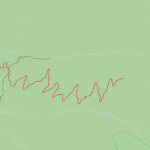In 1905, the Bluebell lead/silver mine had been resurrected by the Canadian Metal Company. In order to develop the mine, a water pipeline was built to generate power to operate the mill and pumps.
The 4km trail and wood stave waterline was built by mineworkers under the direction of Count Edouard Riondel, president of the French-owned company.
This gravity fed water system had a head of 700 feet and generated 475 horsepower at the mine site.
This pipeline operated intermittently for more than 20 years before the mine closed during the Great Depression. Most of the wood staves have long since decayed, leaving a roll of rusty wire and rock retaining walls.
The more interesting aspects of the Waterline Trail include: the intake at the old dam on Tam O’Shanter Creek, wooden cribbing, rock walls, circular flanges which were rock-bolted to the canyon walls and held the suspended pipeline, and the remains of an old cedar log cabin called “Tam O’Shanter Hotel”.
The East Shore Trail and Bike Association has reestablished the historic trail and built a crown land connector to the community of Riondel.
There are a few ways to experience this trail. You can drive/ride up the Tam O’Shanter Forest Service Road 2.6 km to access the top canyon portion (Canyon segment not designated for MTB). You can descend on the trail back to Riondel from the 2.6km marker. The complete trail can be accessed from Riondel Rd North.
After exploring the canyon by foot, you can bike down the whole trail to the Riondel North Rd Trailhead.
Besides the Canyon Segment (hiking only), the trail is a multi use non-motorized trail. Trail courtesy in the form of communication and slowing down when passing other trail users is crucial.
The Riondel North Rd is in a residential neighborhood. Please respect our trail neighbors. #leavenotrace principals apply.

